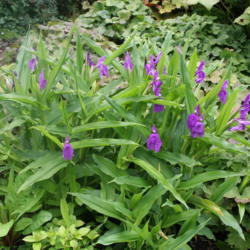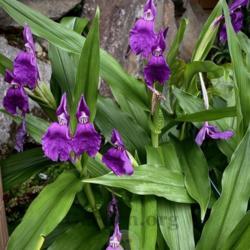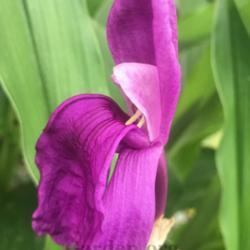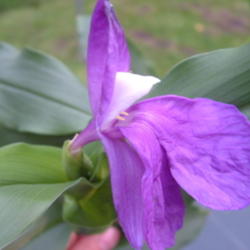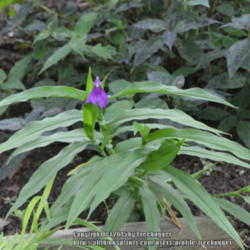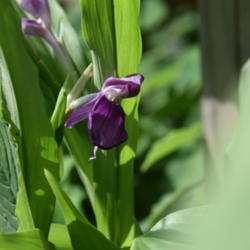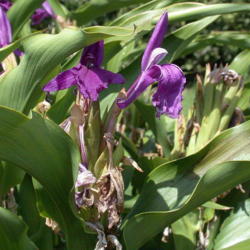"Roscoea auriculata is a perennial herbaceous plant which occurs in grasslands, between 2,400 and 2,700 metres in the Himalayan mountains of Tibet, Bhutan, Nepal and Sikkim.
Like all members of the genus Roscoea, it dies back each year to a short vertical rhizome, to which the tuberous roots are attached. When growth begins again, "pseudostems" are produced: structures which resemble stems but are actually formed from the tightly wrapped bases (sheaths) of its leaves. R. auriculata is usually 20–40 cm tall, with three to seven leaves. The blade of the leaf (the part free from the pseudostem) is 7.5–20 cm long by 2–2.5 cm wide. The leaf sheath is smooth (glabrous) and purple in colour. At the junction of the blade and sheath there are ear-shaped (auriculate) outgrowths.
In its native habitats, R. auriculata flowers between June and August. The stem (peduncle) of the flower spike does not emerge from the leaf sheaths. Several purple or white flowers are produced. Membranous bracts, 2–2.5 cm long subtend the flowers.
Each flower has the typical structure for Roscoea (see that article for labelled images). There is a tube-shaped outer calyx, about 3.5 cm long. Next the three petals (the corolla) form a tube longer than the calyx, terminating in three lobes, each about 3–3.5 cm long: an upright central lobe and two slightly shorter side lobes. Inside the petals are structures formed from four sterile stamens (staminodes): two lateral staminodes form what appear to be small white petals, about 1.5–2 cm long, upright and hooded; two central staminodes are fused at the base to form a lip or labellum, about 3.3–4.8 cm long by 3 cm wide. This is bent backwards and split at the end into two lobes.
The single functional stamen has a linear anther, about 1 cm long, borne on a 1 cm long filament. A short spur is formed from the connective tissue between the two capsules of the anther. After flowering, a capsule 2–3 cm in length is formed containing brown seeds.
R. auriculata, like other Roscoea species and cultivars, is often grown in rock gardens. Plants generally require a relatively sunny position with moisture-retaining but well-drained soil. As they do not appear above ground until late spring or even early summer, they escape frost damage in regions where subzero temperatures occur. R. auriculata has been described as one of the "most commonly grown and easy species". When grown at the Royal Botanic Gardens, Kew, it was given a position which was sunny in the morning but shaded in the afternoon; it should not be planted in full sun or in too hot a position. Deep violet-purple and white forms are in cultivation."
Taken from wikipedia's page at:
http://en.wikipedia.org/wiki/R...
